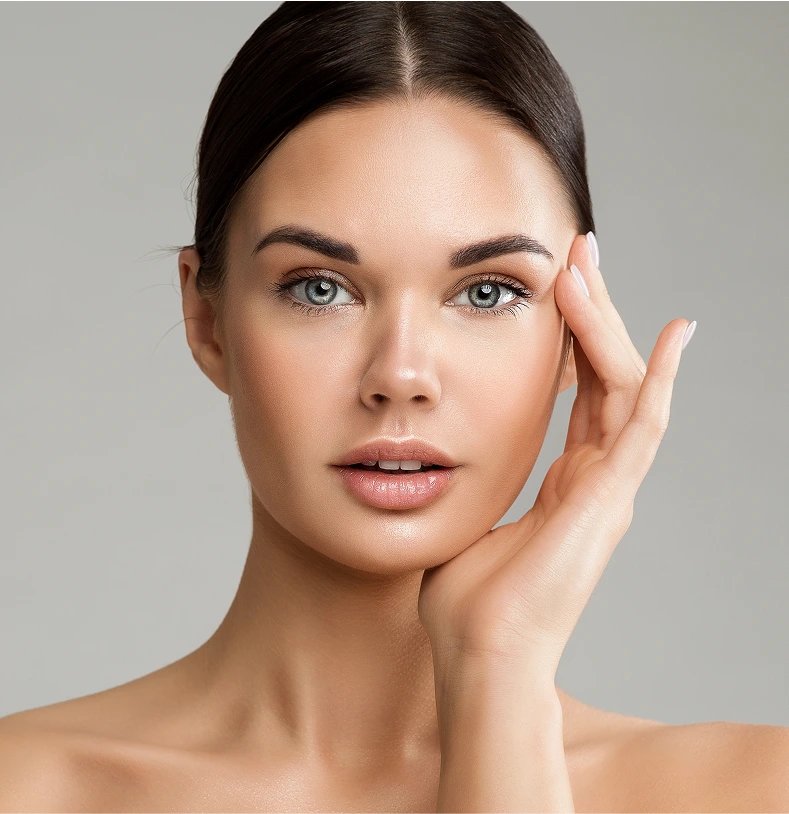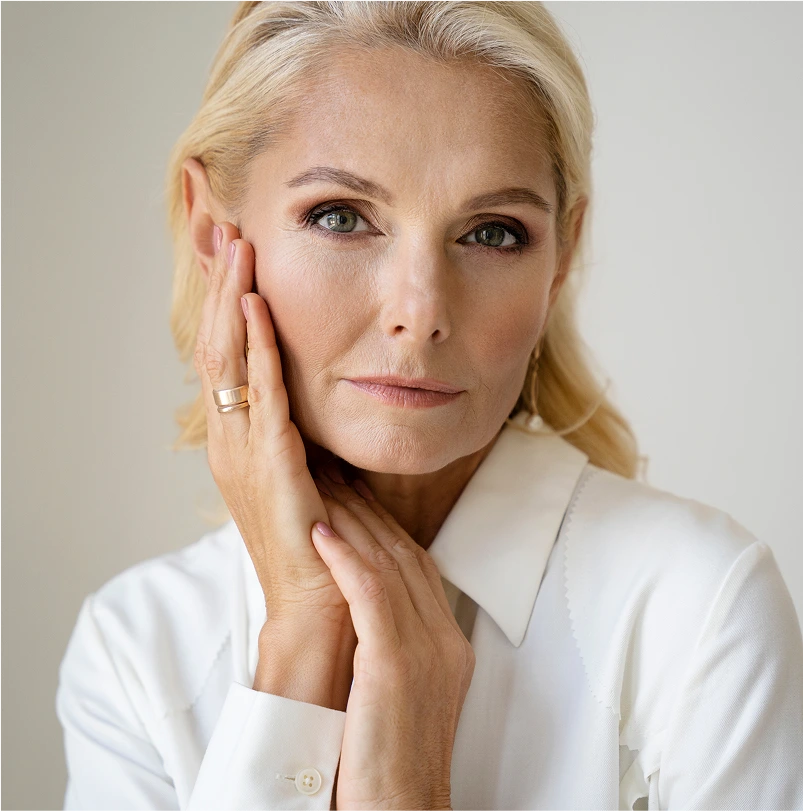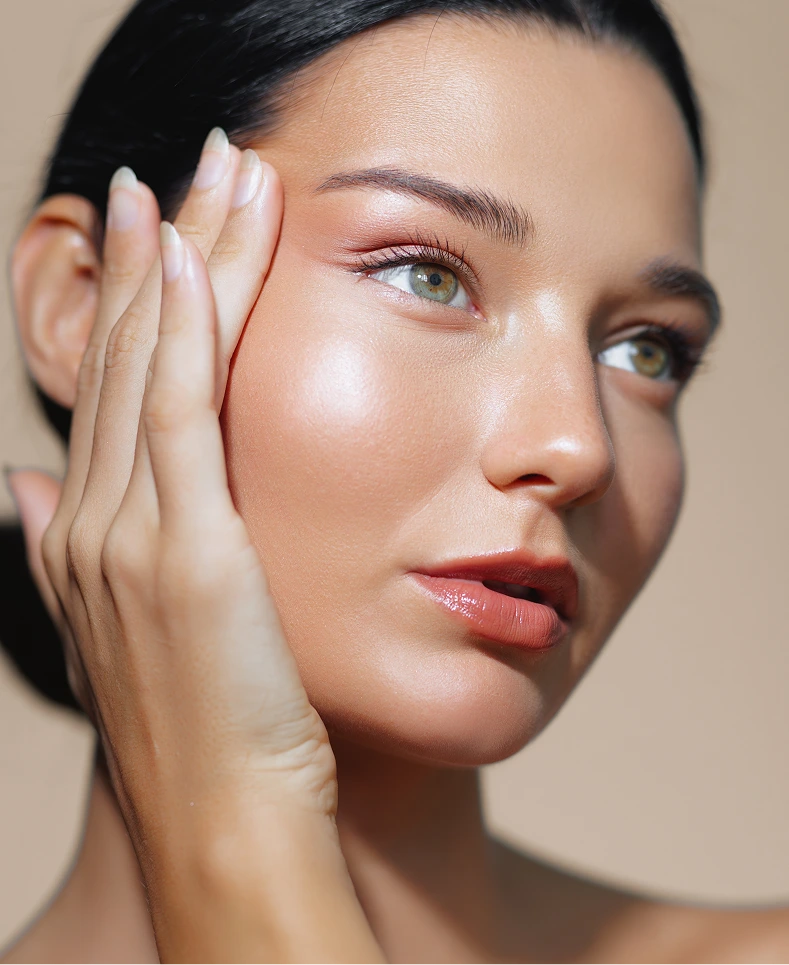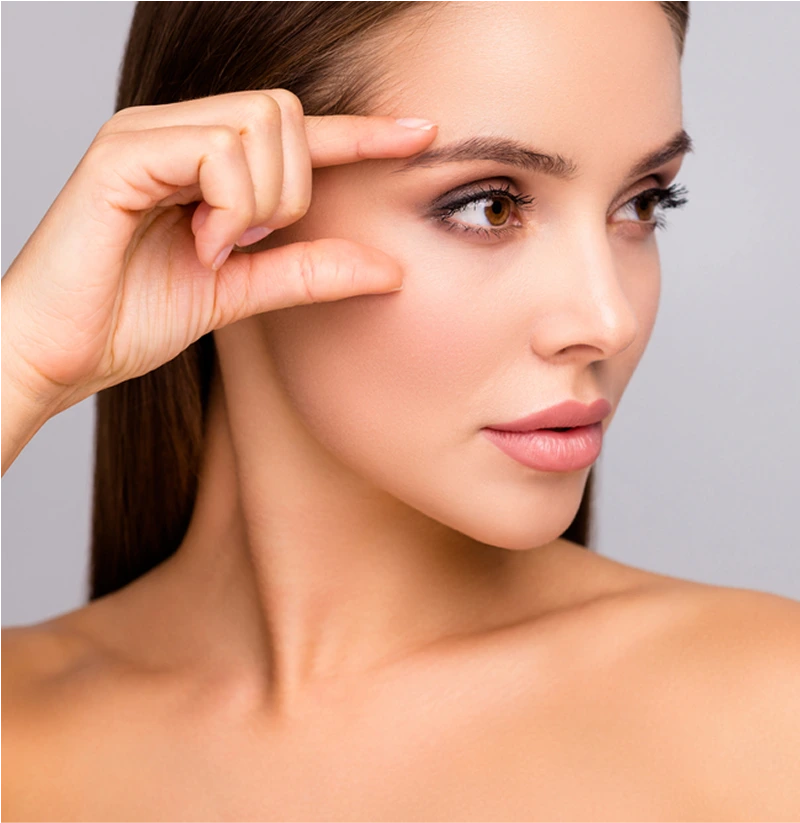Blepharoplasty
in Houston and Pearland, TX
Dr. Hankins and his dedicated staff are lifting spirits and droopy eyelids all over Houston, Pearland, and Lake Jackson, TX. The occurrence of bags under the eyes or bulging and redundancy of the upper and lower eyelids is multi-factorial. First are the effects of solar exposure, which results in crow’s feet, dark circles, and sagging upper eyelids. Loss of elasticity of the orbital septum that contains the intra-orbital fat can result in the appearance of excess skin in the lower eyelids.
Descent of the malar fat pad of the mid-face results in apparent excess fat of the lower eyelids and loss of soft tissue coverage of the lower orbital bony rim, which commonly becomes noticeable in middle age. Concurrently, there is an enlargement of the orbit due to the resorption of bone as part of the aging process. Lastly, a generalized loss of fatty tissue on the face results in a deflationary effect of the mid-face, accentuating the impact of malar fat pad descent—the result is eyes that have you looking exhausted all day long.
Premier Plastic Surgery offers eyelid surgery to enhance your appearance, eliminate droopy eyes, and help build confidence. Dr. Hankins and our dedicated staff are revitalizing droopy eyelids all over the great state of Texas. Your eyes are next up for a refresh.
Our Houston area office is located in Pearland, TX, conveniently located to see Eyelid Surgery patients in Lake Jackson, Clearlake, Friendswood, Marvel and the surrounding areas of South Houston.
Eyelid Surgery, also known as Blepharoplasty, is a surgical procedure used to remove excess fat and improve the appearance of loose skin. Excess skin and dark circles surrounding the upper and lower eyelids can cause someone to look old, tired, or angry. Eyelid surgery in Houston is a commonly sought-after procedure for individuals with excess eyelid skin or orbital fat. Blepharoplasty can reduce the appearance of fine lines and dark under-eye circles, and this surgery can also help improve your vision and provide a refreshed appearance.

Upper eyelid surgery, also known as upper blepharoplasty, is designed to remove excess skin and fat from the upper eyelids, enhancing the eye’s appearance and reducing signs of aging. By addressing droopy eyelids and improving the overall contour of the eyes, this surgery can help create a more youthful, refreshed look.
Lower eyelid surgery, or lower blepharoplasty, targets under-eye bags and sagging skin to create a smoother, more youthful appearance. This procedure can reduce puffiness, eliminate dark circles, and tighten the lower eyelid area for a rejuvenated look.
Quad blepharoplasty is a comprehensive approach that combines both upper and lower eyelid surgery, making it particularly effective for individuals with hooded upper eyelids and pronounced under-eye bags. This procedure addresses excess skin, fat, and sagging in all four eyelids, resulting in balanced and harmonious outcomes. By simultaneously rejuvenating the upper and lower eyelids, quad blepharoplasty can significantly improve the overall eye contour, reduce signs of aging, and restore a more alert and refreshed appearance.
The first step in pursuing eyelid surgery in Houston is, quite frankly, the easiest. All you need to do is schedule a consultation with Dr. Hankins at Premier Plastic Surgery. During this consultation, Dr. Hankins will evaluate your eyelids, discuss your goals and expectations, and determine if you are a suitable candidate for the procedure. This personalized approach ensures that you receive professional advice and a tailored treatment plan to achieve the best possible results.

On the day of your eyelid surgery at Premier Plastic Surgery in Houston, you can expect a welcoming and comfortable environment. After arriving at the clinic, you will meet our friendly staff. Once settled in, you can expect a comprehensive and personalized approach to address upper and lower eyelids if needed. Here’s what you can anticipate for each:
Depending on your preference and Dr. Hankins’ recommendation, you will be administered either local anesthesia with sedation or general anesthesia. Dr. Hankins will then make discreet incisions along the natural creases of your upper eyelids to minimize visible scarring. Excess skin, muscle, and fat will be removed or repositioned for a more youthful and rejuvenated appearance. Once the necessary adjustments are made, the incisions will be carefully closed with sutures or surgical adhesive.
Similar to upper eyelid surgery, you will receive either local anesthesia with sedation or general anesthesia. Dr. Hankins may make incisions along the lower lash line or inside the lower eyelid to access the underlying tissues. Excess fat may be repositioned or removed depending on your specific concerns to reduce puffiness and under-eye bags. Dr. Hankins will tighten the skin and underlying tissues to smooth out wrinkles and fine lines. The incisions will be meticulously closed with sutures or surgical adhesive to promote optimal healing.
Dr. Hankins and his team will prioritize your safety, comfort, and aesthetic goals throughout upper and lower eyelid surgeries, ensuring a positive surgical experience and beautiful results.
After eyelid surgery, patients typically experience swelling, bruising, and mild discomfort around the eyes. To aid in recovery, it’s essential to rest with the head elevated, apply cold compresses, and adhere to any prescribed medication or eye care regimen.
If used, sutures are usually removed within one to two weeks, and a gradual return to normal activities is encouraged. While full results may take several weeks, regular follow-up appointments with our team will help monitor progress and ensure optimal healing.

A brow lift is a cosmetic procedure, also called a forehead lift, designed to elevate sagging brows and smooth forehead lines. Many patients choose this procedure to improve appearance, creating a refreshed, youthful look that complements eyelid surgery. By addressing the upper portion of the face, a brow lift can reduce the appearance of frown lines and enhance overall facial harmony.
A facelift is a comprehensive facial rejuvenation procedure that focuses on tightening sagging skin, repositioning fat, and improving the contour of the under-eye area. Many patients appreciate that this surgery provides noticeable results with minimal scarring, leaving the face looking naturally refreshed rather than overdone. By targeting multiple areas simultaneously, a facelift can restore youthful proportions and enhance the overall facial balance.
A neck lift is a specialized neck surgery often performed alongside an eyelid lift to create a more cohesive rejuvenation of the lower face and neck. This procedure addresses sagging skin, excess fat, and muscle laxity in the neck, producing a smoother, more defined jawline. Many patients choose to combine a neck lift with blepharoplasty to achieve balanced, natural-looking results that improve overall facial aesthetics.
Laser skin resurfacing is a treatment typically performed to improve the texture and tone of delicate skin, particularly in areas affected by fine lines, sun damage, or acne scarring. This procedure can complement eyelid surgery by smoothing wrinkles and enhancing the appearance of the surrounding skin. Many patients appreciate how laser resurfacing rejuvenates the skin while targeting areas that are too delicate for more invasive treatments.

The best candidates for eyelid surgery are individuals who have good overall health and realistic expectations about the procedure’s outcomes. Ideal candidates typically experience issues such as:
Our blepharoplasty procedures in Houston offer numerous benefits that enhance appearance and functionality. We can rejuvenate the eye area with perks such as:

The cost of eyelid surgery (blepharoplasty) at Premier Plastic Surgery starts at $3,000 per treatment area and may increase depending on each patient’s goals and needs. This price point applies to in-office eyelid surgery.
We recommend scheduling a consultation with our eyelid surgeon, Dr. Christopher Hankins, for a personalized cost estimate and detailed information about the procedure. During your consultation, our patient coordinator will provide a customized quote and answer any questions you may have regarding an eyelid surgery procedure.
Choose Dr. Hankins for your eyelid surgery in Pearland and the surrounding Houston area because he sets the bar in Texas – and in Texas, we do things with confidence and stride. With a commitment to patient-centered care, Dr. Hankins evaluates each patient comprehensively, ensuring treatments align with their best interests. As a plastic surgeon specializing in face, breast, and body aesthetic surgery, Dr. Hankins brings extensive training in hand surgery and breast reconstruction after cancer.
With five plastic surgery fellowships under distinguished mentors in the US and UK, including at Baylor College of Medicine and the University of Alabama at Birmingham, Dr. Hankins is dedicated to delivering exceptional results. He earned his medical degree from the University of Texas. In the medical branch at Galveston, he completed rigorous training in general surgery and anatomic and clinical pathology.

The number of appointments required for eyelid surgery varies depending on individual needs and treatment plans. Typically, patients have an initial consultation to discuss their goals and medical history, followed by a pre-operative appointment to review the procedure and any necessary preparations. Additional follow-up appointments may be scheduled after surgery to monitor healing and address any concerns.
The timeline for seeing results from eyelid surgery varies among individuals. While some patients may notice improvements in the appearance of their eyelids immediately after the procedure, it can take several weeks to months for swelling and bruising to entirely subside and for the final results to become apparent. We can discuss this timeline during your consultation.
Injectable treatments, such as dermal fillers or neuromodulators, can provide temporary improvement in the appearance of fine lines and under-eye hollows. However, they cannot fully address the excess skin, fat, or structural changes that occur with the natural aging process. Most patients who desire long-lasting, transformative results choose eyelid surgery to achieve a more youthful and refreshed appearance.
Yes, eyelid surgery can sometimes improve vision in patients whose droopy upper eyelids obstruct their line of sight. By removing excess skin and lifting the eyelids, this procedure can reduce interference with peripheral vision, making daily activities such as reading, driving, or sports safer and more comfortable.
Scarring from eyelid surgery is typically minimal and well-concealed within the natural creases of the eyelids. In the case of upper eyelid surgery, scars are usually hidden within the fold of the upper eyelid. In contrast, for lower eyelid surgery, scars may be located just below the lower lash line or inside the lower eyelid. Over time, these scars tend to fade and become less noticeable, especially with proper wound care and scar management techniques recommended by our team.
To allow for proper healing, you should avoid strenuous exercise and activities that elevate your heart rate for at least two weeks following eyelid surgery. It’s also important to follow your surgeon’s instructions regarding post-operative care and activity restrictions to ensure optimal results and minimize the risk of complications.
Combining eyelid surgery with other procedures is possible and often done to address multiple cosmetic concerns simultaneously. Procedures like a neck lift or a brow lift can be added to your procedure plan. It’s essential to discuss your goals and options with Dr. Hankins during your consultation to determine the best approach for achieving your desired outcomes safely and effectively.
Eyelid surgery, like any surgical procedure, carries some risks and potential complications. These may include:
Many patients can safely combine eyelid surgery with other body procedures, such as a breast lift, thigh lift, or targeted removal of fat pockets, depending on the overall surgical plan. These combined procedures are often performed on an outpatient basis, allowing for a streamlined recovery while achieving multiple aesthetic goals in a single surgical session.
Finding a skilled plastic surgeon in Houston involves several steps to ensure you choose a qualified and experienced professional. Look for surgeons like Dr. Hankins with high ratings and positive reviews specifically for eyelid surgery.
The malar fat pad can be accessed through a lower blepharoplasty incision. Elevation of the malar fat to correct its descent, cheek implants to augment the mid-face, or fat grafting are surgical techniques that may be necessary to counteract the deflationary effects of generalized fat loss of the face, as noted above.
Mid-facial augmentation may also be beneficial if the mid-face is recessed behind the vector of the cornea of the eye, a so-called negative vector mid-face. A high lamellar SMAS lift can also augment the mid-face.
In younger patients with bulging lower eyelids but without excess skin, it is possible that a transconjunctival lower lid blepharoplasty may be sufficient to correct the deformity by simply removing the apparent excess fat.
In older patients, the skin of the lower eyelids usually suffers from elasticity loss from solar elastosis, requiring reconstructive surgery and lower eyelid rejuvenation. Skin resurfacing from either a chemical peel or laser treatment may be added to correct the damage inflicted by the sun.
When there is skin laxity of the lower eyelids that can be demonstrated by a snap test or by the visibility of the sclera between the iris and the lower eyelids, the eyelid should be tightened using either a lateral canthopexy or a lateral canthoplasty.
In the surgical technique of a canthopexy, the lateral canthal ligament is tightened, whereas in a canthoplasty, the lower division of the lateral canthal ligament is divided and reattached to the thickened periosteum of the orbital rim known as the arcus marginalis. In some cases, a small length of the lower tarsal plate is denuded of mucosa and skin and then directly attached to the orbital rim, known as a tarsal strip procedure.
In most cases of lower eyelid blepharoplasty, it is prudent to incorporate either a canthopexy or canthoplasty as a preventative measure against possible complications postoperatively.
In examining the upper eyelid, it is vitally important to distinguish between excess skin of the upper eyelid and ptosis of the brow. The eyebrow sits typically at the level of the upper bony rim of the orbit, with the outer or lateral third of the brow in women projecting slightly above the rim. If this is not the case, correction of the brow via upper eyelid surgery is vital to creating the natural contours of their desired facial structure.
Many plastic surgeons do not tell the patient that the frontalis muscle, which elevates the brows, may be spasmed in the case of brow ptosis to maintain the field of vision. When the obstructing skin is removed in an upper lid blepharoplasty, the frontalis muscle will relax, settling the brows to a lower position than was present preoperatively. To obtain the optimal result, it may be necessary to perform both a brow lift and an upper blepharoplasty.
Schedule a Consultation
If you are tired of your sagging, droopy eyes and want to turn back time, contact Premier Plastic Surgery today for a free consultation! We’re happy to discuss all your options so you can make a well-informed decision. Call (713) 370-4433 or come by in person today. We proudly serve residents in Pearland and the Houston area.